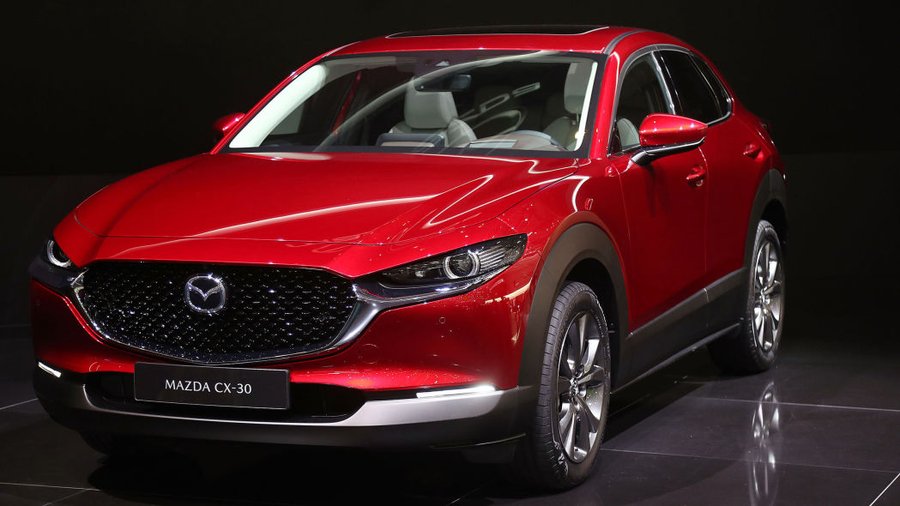Mazda plans to launch an EV in 2020, plug-in hybrid by 2022

Thanks to an interview Automotive News Europe conducted with Mazda president and CEO Akira Marumoto, we have more insight on Mazda's plans to lower its vehicle emissions in Europe. This will undoubtedly bring changes to the U.S. lineup, too, but The Continent sees the first fruits in part because Mazda is well over the European Union's fleet CO2 emissions target for 2021 of 95 g/km. In response to how Mazda plans to achieve the necessary reduction, Marumoto said the carmaker will launch its first EV in 2020 and have a plug-in hybrid on the road in 2021 or 2022.
First, some clarification on the emissions numbers and timeline. The 95g/km figure is based on the New European Driving Cycle (NEDC) emissions schedule being phased out next year; the AN piece cites JATO Dynamics findings that Mazda Europe's fleet CO2 average is 135.2 g/km.
The new Worldwide Harmonised Light Vehicle Test Procedure (WLTP) schedule comes into full effect in 2020, the fleet CO2 target under that methodology translating to 114.9 g/km. The rules dictate that 90 percent of an automaker's range needs to meet the cap number by the end of 2020, the rest of the lineup must come into compliance by the end of 2021. Failure means enormous fines. Industry analyst IHS Markit estimates "average fines for those not complying could reach €624 ($707) per vehicle at the end of 2020, with a further €190 ($215) increase in 2021." The penalties quickly grow so large that Fiat will reportedly pay Tesla hundreds of millions of euros to pool their fleets and avoid an even larger bill.
Mazda's most popular vehicle in Europe is the CX-5 with CO2 emissions ranging from 128 g/km to 150 g/km. On top of that, for a small automaker, the size of potential fines has material effect on the R&D budgets necessary to develop the technologies that will lower emissions, and whatever EV Mazda launches in 2020 needs to sway legions of customers into purchases to be of practical use. This will be challenging. A line in the IHS Markit summary about the industry in general states, "Once in 2021 and subject to full WLTP regulatory monitoring, only a seismic shift (over the baseline) in consumer demand for BEV ('Electric-Plug-In') and PHEV ('Hybrid-Full Plug-In) will result in the full mitigation of EU28 fleet level excess emissions premiums."
Mazda hooked up with Toyota and Denso in 2017 on a joint venture called EV Common Architecture Spirit Co Ltd to develop EV technology. Marumoto said his company is working on an EV architecture with Toyota, but the battery-electric car that debuts next year will ride on a Mazda platform. And it might include a rotary engine used to recharge the battery – Marumoto said a new rotary's "first application will be as a range extender for EVs." The setup could give us the first preview of what Mazda powertrain chief Ichiro Hirose dubbed "XEV," a platform that can act as mild hybrid, series hybrid, or battery-electric vehicle with a rotary range extender.
So 2020 will be a difficult year for the brand, but the good news is ramping up. The Skyactiv-X engine produces less than 100g/km of CO2, and comes on line this year. Diesel hybrids are expected to take a larger stake in the powertrain mix, Marumoto saying these are the "most efficient" options for the crossovers and SUVs that represent about 60 percent of Mazda's global sales. As well, "a new generation of diesels" is on the way, based on Skyactiv-X technology. And the company will continue to develop its own engines - like the Skyactiv-X inline-six gas and diesel motors - because Mazda "[has] to focus on our uniqueness."
If you're looking for different kind of news on a rotary-powered car, though, Marumoto has nothing to offer. He told AN, "Inside Mazda, we all have the dream of seeing one day a vehicle powered by a rotary engine. But given the number of things we have to do, we had to put this on the back burner, and we have no time frame."
